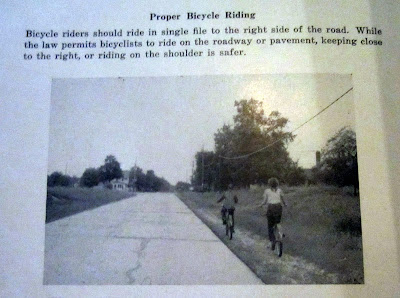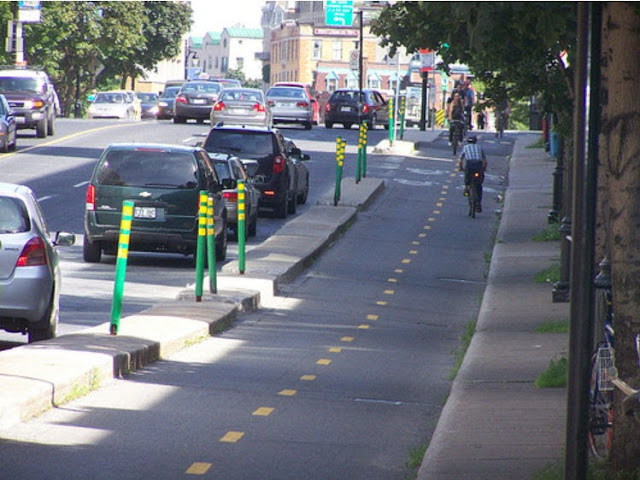 |
| [Hennepin County's diagram of the proposal.] |
"It's perfectly fine! I use it all the time."
We were on a bike ride around the city, and as usual on a group rides around the city, we were talking about other bike rides. I was trying to make the case for the proposed Minnehaha Avenue cycletrack, a new type of "Dutch-style" infrastructure which creates a separated, protected lane for bicycles between the sidewalks and cars.
My friend's reaction is not uncommon among bicyclists in Minneapolis. If you hang out with enough people who ride everywhere around the city, you'll find a lots who are reluctant to embrace cycletracks. They think they're unsafe or too slow, an necessary distraction. Pro-cycletrack people on the other hand, and I count myself among them, usually respond by saying "yeah but they're safer," or "we need them to encourage more people to ride bicycles."
Later that day, I got the following message from a Twitter follower:
@BillLindeke Time for another article on Minnehaha Avenue? My son was terrified last time we rode it...so much potential!!!My friend, a mother with two kids, has a completely different opinion about the current state of Minnehaha Avenue. For her, the status quo is not working well at all. Bicycling down Minnehaha today, even though it has a decent bike lane and relatively calm traffic, doesn't work well for her and her family.
And that's the key to why we need cycletracks. The status quo of bicycling in the Twin Cities works well for a small but significant number of people, a group that skews young, male, wealthier, and white. It works so well that Minneapolis is justly famous for being a great place to ride a bicycle.
But the same streets that work well for those people fail large numbers of others, folks that might have a bicycle in their garage, might want to try riding a bike and getting exercise, but won't go beyond the Midtown Greenway or the river paths because they don't enjoy sharing the road with cars. If we want to grow bicycling beyond our current 6-10% group, we need roads that appeal to even more kinds people. That's exactly why we need to build cycletracks, starting with Minnehaha.
History of the Cycletracks in the US
 |
| [A 1930s UK cartoon lampooning cycletracks.] |
The cycletrack debate has long roots in the US, and boils down to two different philosophies about who rides bicycles, and why and how they choose to ride.
Cycletracks grew up in Europe, primarily in Holland, Denmark, and Germany. They first came to the US back in the 60s in Davis, California. Back in the early days, according to bicycle historian Bruce Epperson, bicycle advocates at UC-Davis wanted to adopt an “egalitarianist” approach to bicycle design. These early cycletracks were modeled after the Northern European cycling philosophy that wedded separated designs of bicycle paths with a geographic system that encouraged utility trips through urban space, in this case, through the sprawling campus of an agricultural university.
The key difference between the cycletrack approach and the status quo in the US was that cycletrack planners saw bicycling as primarily for transportation as opposed to recreational or athletic purposes. This difference meant that bicycle planners had to simultaneously design routes for the broadest possible audience (“lowest common denominator”), while placing routes through key parts of the city to link important destinations.
 |
| [1950s Minnesota bike safety illustration, telling people to get off the road.] |
The answers to these questions largely controlled how bicycle infrastructures were designed, and what kinds of places that were built.
For the egalitarian “bikeway” planners, the needs and desires of “experienced and competent individuals” were not important. On the contrary, designing and accommodating bicycle facility meant “crimp[ing] the style” of this group in favor of spaces that would accommodate and welcome slower-moving, younger, and less well-to-do groups of people riding bicycles for necessity and transportation (Sommer, quoted in Epperson 2013 36).
Understandably, this philosophy provoked a negative reaction by influential bicycling advocates, who at the time were focused on working through some early attempts at guides for bicycling safety and bicyclist education. For example, one influential bicycle engineer described “transportation and utility aspects” of cycling as being “only offsprings” of recreational riding and competitive racing (Konski quoted in Epperson 2013 31). Konski was emphatic about the need for competitive bicycle racing to serve as a model for riding. In 1972, he wrote:
Why is it important to advance the sport of racing if we are to provide bike routes and bike paths? Because if the public understands the sport and learns why the serious cyclist does the things that he does, the individual, though he may not be interested or capable of racing, will be better able to apply this knowledge to his own riding.
(Konski 1973)
Bicycling is a sport of skill – a skill that increases throughout your life. Take every opportunity to test yourself. Then when an emergency comes, your reactions will be correct and automatic.
(Delong 1970)
Delong’s columns attempted to shape how cyclists ride, performing critiques of their spacing, posture, and attitude towards riding on the roadway.

During this early pioneering era, 70s-era advocates, using safety as a frame around which to construct a narrative, were simultaneously developing courses intended to instruct riders in bicycle skills. Unfortunately, particularly once state governments became focused on legislating cycling, separate governmental safety regulations ended up making decisions that set in motion heated battles over how to ride properly, and resulted in derailing the national momentum behind the construction of off-street bicycle paths.
The Importance of Minnehaha Avenue
Fast forward fifty years, and today we're again debating whether to build Dutch-style cycletracks on streets in the US. A lot of the same arguments appear, particularly the idea that cycletracks are less safe, that teaching vehicular cycling is the key to safety. However, as the Minneapolis Bicycle Coalition suggests, cycletracks are only less safe if they're very badly designed. Properly done, cycletracks calm traffic and provide a buffer between cars and bicycles. Not only are they safer, but they feel much safer, and will encourage many more people to ride bicycles in Minneapolis.
The key political difficulty about building cycletracks in any city is that you're designing for an audience that doesn't quite exist yet. In Portland, bicycle planners use a simplified spectrum of potential bicyclists, different groups of people that might be interested in riding a bicycle someday in the city. According to the Portland schema, one-third of people just aren't going to ride a bicycle. You'll never talk them out of their cars. On the other end, about 1% of people are super-committed to bicycling. They'll ride in winter, down a 4-lane arterial, or through a sharknado. Then another 7-8% will ride in favorable conditions, for example, this group is quite happy on a bike lane like Minnehaha.
 |
| [The Greenway: comfortable even in winter.] |
The Midtown Greenway is a great model for the kind of bike infrastructure that will appeal to the majority of Minneapolis. But moving the city past this point, and trying to design 'greenway-like' spaces for people to ride, is a challenge. It means trying some new ideas with our streets, re-thinking how we apportion space to cars, bikes, and people on foot.
Portland and Park Avenues are a big first step, but the real answer is cycletracks or on-street greenways. So far, Hennepin County seems not to be taking the proposed Minnehaha cycletrack very seriously. They're clinging to out-moded traffic projections, and trying to use trees as a fig leaf for criticism.
There's a meeting on this tonight! It's from 5-7 p.m. Minnehaha Communion Lutheran Church, 4101 37th Ave. S.
If we want to really embrace bicycling in Minneapolis, not just as a trendy symbol, but as a way to get around for everyone, we need Hennepin County to start building cycletracks like this one.
 |
| [Cycletrack in Montreal.] |
 |
| [Cycletrack in Chicago.] |
 |
| [Cycletrack in New York City.] |
References:
-->
Delong, F. (1970) “Safety: A bicyclist proficiency course.” Bicycling
Magazine. 11(3). 22—23, 32.
Delong, F. (1971) “Cyclist safety and Proficiency course;
Part 10, Club riding and touring skills.” Bicycling Magazine. 12(5).
20—21.
Delong, F. (1972) “Bicycle proficiency: Where on the road?” Bicycling
Magazine. 13(11). 36—37.
Epperson, B. (2013) “Bicycle Planning, American Style: A
history of vehicular cycling 1968 – 1982.” Self published. BruceEpp@aol.com
Konski, J. (1973) “It’s up to you.” Bicycling Magazine.
June 1973. Vol 14. 20 –23.

7 comments:
Nicely put. I think we can go father with Minnehaha than just including a cycletrack. I think it has the potential to be a wildly successful linear park that would be a significant addition to Minneapolis'already impressive urban park ammenities. I think it could be an ammenity on the scale of an additional lake in the chain of lakes. Let's be creative and take advantage of this opportunity to think ahead.
I appreciate all the effort to raise awareness and support for a Cycletrack on Minnehaha.
Everything I've read indicates the city is looking to re-do Minnehaha between Lake Street and 46th.
It seems like restoring bike traffic to the previous configuration at Lake Street would be an absolute fiasco. (I can't believe the county didn't mention that and instead focused on trees.)
I don't think it'd be quite a fiasco. The key there would be somehow continuing the separated treatment forward to the Midtown Greenway connection point, for people that want a 'safe' experience for their whole ride.
You just know that even if they build a cycletrack, certain Type A bicyclists will INSIST on still riding in traffic.
We're you aware that Hopkins is proposing a cycle track or Blake Avenue? It would become a feeder to the SW LRT trail and the future LRT station. There is tremendous excess lane spacing due to the county road segment of Blake Avenue getting a widening in the distant past for the disappearing warehouse and industrial businesses of the area.
I am down with this suggestion. Cars are overrated; not to mention dirty. Parking lots would be smeared by all these tire marks caused by weight and rubber. If there weren't all these equipment around to clean up after their mess, then we'd all be walking in muck on the way to our offices or something!
TotalCleanEquip.com
As a cyclist in Chicago, I wouldn't point at the Dearborn protected bike lane as a good example of how to construct cycletracks. It's too narrow, was constructed on a very busy one-way street (ignoring existing one-way bike lanes on adjacent one-way streets), was constructured on a street with many intersections (giving ample with opportunity for right hooks), and almost completely hides cyclists from drivers' view with dense, heavily used parallel parking.
Post a Comment